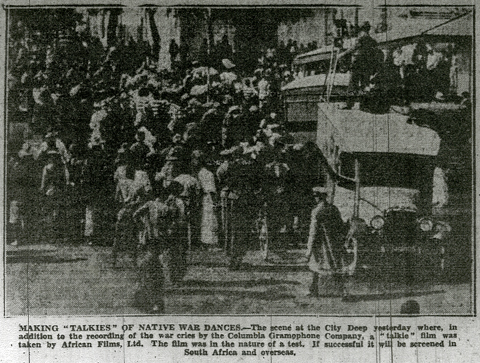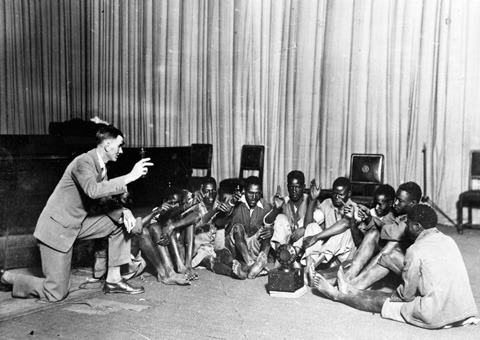LINER NOTESADDITIONAL NOTES By Siemon Allen These eight recordings by the City Deep Natives, directed by P. Alexander, were made on Sunday, June 29th, 1930 at the compound of City Deep mine in Johannesburg and were all issued on Columbia's light-green Regal label. Regal had been established as a mid-priced label by the Columbia Graphophone Company in 1914. The company shifted their coupling number prefix for UK domestic issues to MR in March 1930. Some have said that the MR denotes “Magenta Regal” which also happens to be the colour of that label. Likewise this might explain why the light-green labels of the South African issues were given a GR prefix, perhaps for “Green Regal”. After Gramophone Company and the Columbia Graphophone Company merged to become EMI (or Electric and Music Industries Limited) in March 1931, both company's budget labels merged to become the Regal Zonophone label. The first records on this new label were issued in January 1933. An example by the St. Peter's Choir (GR 1) can be viewed here. Given the change in number prefixes by the Graphophone Company, it is likely that the South African GR series was also issued after March in 1930. The series included songs in a range of Southern African languages including isiXhosa, Sesotho, Afrikaans, Chopi, and Chikaranga (or Shangaan). The highest number I have found to date is GR 54 by Die Vyf Vastrappers. I was able to exactly date these recordings after I found an article covering the historic day at City Deep mine in the Rand Daily Mail. According to the paper, the Columbia Graphophone Company, the UK-based competitor of Gramophone Company, sent two recording experts, Gustav W. Cook and Frank Chown to Cape Town around May, 1930. They had come at the invitation of Messrs. H. Polliack and Co., Ltd. who were the agents for Columbia in South Africa. After making about 150 recordings of mostly Afrikaans music in Cape Town, the pair arrived in Johannesburg on June 11th and began recording at the studios of ABC (African Broadcasting Company) on June 16th, 1930. (RDM, 1930-06-05, 1930-06-12, 1930-06-17, 1930-06-30) Over the next few weeks the experts made a series of recordings at various venues across the city including the Johannesburg City Hall, ABC studios and the mine. On Sunday, June 29th, Cook (the recorder) and Chown (the engineer) came to City Deep mine to document what must have been a momentous occasion. A film crew from African Films, Ltd. had also been invited, creating quite a spectacle at the work site. "Simultaneously [...] the African Films Production Company had their two recording vans, and a big staff of operators endeavoring to give the world what ought to be a really thrilling sound picture. [...] Microphones with lines into the Columbia apparatus set up in the compound manager's office, and to African Films vans, hung all round, and movie cameras were everywhere, many of them operated by amateur enthusiasts, who hope, when the Columbia records are made, to be able to give "sound-film" shows of their own at home." (RDM, 1930-06-30) Many mines had performance groups that often competed in formal competitions organised by the mine (See Hugh Tracey's book African Dances of the Witwatersrand Gold Mines) "City Deep Natives" refers to various groups of artists associated with the City Deep mining company. Though all eight recordings are credited to "City Deep Natives", there are at least two different performing groups over the four discs — a Chopi timbila group on GR 15 and 16 and a Shangaan vocal group on GR 17 and 18. The Rand Daily Mail article details both: "First the stalwart Mchopi "boys" pranced on to the ground on the heels of their wonderously clad leader, and went through a large repertoire of pantomimic dancing, while the musicians played the "Uyeza" (Call to Battle), "Siyalwa" (During the Battle), and "Ndanda" (After the Battle). [...] After the Mchopi tribesman had finished their turn, a Shangaan regiment arrived, accompanied by their "women folk" — other boys playing feminine parts, some of them appropriately costumed, and even carrying sun-shades. The "warriors" shouted their battle songs, and stamped until the ground shook, while the "women" stood in a group and sang admiring responses." (RDM, 1930-06-30) Interestingly here, is the mention of gender role playing. I am amazed listening to these discs and I have often wondered what it must have been like for the recording engineer to hear these tracks for the first time in 1930. To my delight, Frank Chown was asked this very question on the day: "... are you disappointed, or does the thing come up to your expectation?" To which he replied: "It is beyond what I expected, [...] I have recorded weird music in many parts of the world and recently got some quaint stuff in China and Japan, but this has everything else beaten." The article then goes on to detail Chown's concerns with some of the deeper notes of the timbila group: "He was afraid, however, that there was one thing beyond the capacity of the recording system, and that was the bass section of the band. The booming note is of a lower pitch than any other musical instrument can produce. Mr. Chown gave technical reasons, but in effect the trouble is that the low notes vibrate in a fashion that "mushes up" the rest. It may work out all right, but, just to be sure, the fellows with the big mallets in the back row were given a rest while the tunes were repeated without the basses." (RDM, 1930-06-30)  Photo from the Rand Daily Mail, June 30, 1930. Sourced from the South African National Library. The four Regal discs, from which we are today able to hear these recordings, originally formed part of Percival Kirby's personal collection. It is interesting to note that Kirby was present at the City Deep mine performances that day. At the time he was collaborating with a team sent by the Carnegie Institute to document traditional African music. He notes in the article: "Without the aid of the electrical record and the sound-film, [...] it was impossible to note the detail of these native tunes, the sounds are so evanescent." (RDM, 1930-06-30) His hand-written notes on each of the recordings are visible on the labels of the discs. A few weeks later, at the end of July, Kirby was also present at the ABC studios when the Columbia engineers recorded ten "Karanga" men, who had been brought by lorry from Fort Victoria in Rhodesia by Hugh Tracey. The visit was aided by a grant from Witwatersrand University, where Kirby was a professor. In his autobiography Wits End he details their visit: "After these recordings were completed, I had the men brought to my Department, where I questioned them closely with Mr. Tracey's help, and also made phonograph recordings of special features of their music which would have been of no interest to the commercial company but which were of great scientific value. I also set them to work to manufacture one of their characteristic musical instruments, the tshipendani, and was able to observes every stage of the process." (Kirby, WE, p. 226., Thank you to Anthea van Wieringen for leading me to this source.) The visit is captured in an early photograph from the ILAM Photo Archive which shows Tracey conducting the “Karanga” men in front of a microphone at the ABC studios. The meta-data for this image incorrectly states that it was taken “approximately in June 1929” an error that is repeated by Tracey in a number of publications.Tracey later traveled by train with an additional group of “Karanga” men to Cape Town in 1933 when another Columbia unit visited from the UK.  Hugh Tracey with The Chipika Singers, JHB, July 1930. Source ILAM Photo Archive with kind permission. The recordings by the “Karanaga” men were issued on the Regal label as The Chipika Singers (GR 33 - 40) with the matrix numbers WEA 484 - 502. The recordings by the City Deep Natives obviously predate those and have the matrix numbers WEA 238 - 245. To make things a little more complicated these early Regal and Columbia issues have an additional five-digit number in the lead-out of the shellac. At first I thought that these were ‘global’ matrix numbers designated by Columbia’s head office back in the UK while the WEA matrix numbers were applied specifically for the South African issues. But I was told by Rob Allingham that these numbers are "face numbers" that reflect the order of master processing and, unlike matrix numbers, have little historical importance. The numbers for the City Deep Natives ranges from 54971 to 55013 (GR 15 - 18) and have been included for reference in the discography below. A chronological discography of the recordings by the City Deep Natives based on their WEA matrix numbers. City Deep Natives, directed by P. Alexander, June 29th,1930 WEA 238 54971 Uyeza (A call to battle) WEA 239 54972 Siyalwa (Song during battle) WEA 240 54973 Ndando (Song after battle) WEA 241 55013 Ndando (Song after battle) WEA 242 55012 Etinjini Naka Amatonga (The Tongas are our Slaves) WEA 243 NNOD Hayi Wena Mamana Malanga La (Song of mourning after battle) WEA 244 55007 Chinavana Wa Hlula Amatonga (Song of defeat of Tonga by Chinavana) WEA 245 55008 Va Yi Poyilile (They Despise Us) |
CITY DEEP NATIVES
|
||
TRACK LISTING
|
||
ARTISTS
| ||
NOTESI am amazed listening to this disc and I have often wondered what it must have been like for the recording engineer to hear these tracks for the first time in 1930. To my delight, I recently found a newspaper article that discusses what the Columbia recording experts heard that day. (For more detail check out the 'Liner Notes' section across.) Though all recordings are credited to "City Deep Natives", there are at least two different performing groups over the four discs — a Chopi timbila group on GR 15 and 16 and a Shangaan vocal group on GR 17 and 18. "City Deep Natives" refers to various groups of artists associated with the City Deep mining company in Johannesburg. Many mines had performance groups that often competed in formal competitions organised by the mine (See Hugh Tracey's book African Dances of the Witwatersrand Gold Mines) Both tracks remind me of Steve Reich's iconic Drumming composed, after a visit to Ghana, over 40 years later. And certainly a connection to the future polyrhythmic, electronic dance music of the 1990s is inescapable. This particular record was part of a personal collection of 78 rpms that were owned by ethnomusicologist Percival Kirby who, interestingly, was present at the performance. To be sure, Kirby made hand-written notes on many of the labels, for example here on the B-side. At some point the discs were acquired by, Johannesburg collector, Warren Siebrits who subsequently passed them onto the Flat International archive. Many thanks to Warren Siebrits for leading me to this record! |
||
